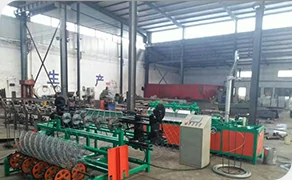 TEL:
+86-13102802206
TEL:
+86-13102802206
 Email:
fencenetting@china.com
Email:
fencenetting@china.com
 Language
Language
 TEL:
+86-13102802206
TEL:
+86-13102802206
 Email:
fencenetting@china.com
Email:
fencenetting@china.com
 Language
Language


The Importance of Stainless Steel Lashing Wire in Modern Applications
Stainless steel lashing wire is an essential component in a variety of industries, prized for its strength, durability, and resistance to corrosion. This wire is particularly useful in applications where weather elements can be challenging and where reliability is paramount. In this article, we will explore the characteristics, uses, and advantages of stainless steel lashing wire, highlighting its significant role across different sectors.
Characteristics of Stainless Steel Lashing Wire
Stainless steel lashing wire is primarily composed of steel alloyed with chromium, which provides its corrosion-resistant properties. Common grades used include 304 and 316 stainless steel. Grade 304 is known for its excellent corrosion resistance and general usability, while grade 316 offers superior protection against chlorides and harsh environments, making it ideal for marine applications.
The wire typically comes in various gauges and lengths, enabling users to select the appropriate size for their specific needs. Furthermore, the wire’s tensile strength ensures that it can withstand considerable pressure and weight, making it suitable for heavy-duty applications.
Applications of Stainless Steel Lashing Wire
One of the most prevalent uses of stainless steel lashing wire is in the construction industry. It is often used to secure scaffolding, bracing, and other structures where stability is crucial. The wire's ability to hold under stress means that it plays a significant role in ensuring safety on construction sites.
In the telecommunications sector, stainless steel lashing wire is crucial for securing cables on utility poles and towers. It keeps these cables taut and protected from the elements, reducing the risk of damage that could lead to service interruptions. Likewise, it is widely used in the electrical industry for grounding and bonding applications, where reliability is essential.

Stainless steel lashing wire also finds applications in the manufacturing of wire rope slings and other lifting equipment. The wire's strength and durability make it suitable for lifting and moving heavy loads safely. Additionally, it is utilized in various agricultural settings, such as for fencing and securing nets around crops, providing both protection and support.
Advantages of Using Stainless Steel Lashing Wire
The primary advantage of stainless steel lashing wire is its corrosion resistance. Unlike traditional steel, which can rust and weaken when exposed to moisture and chemicals, stainless steel maintains its integrity in harsh environments. This property extends the lifespan of projects and reduces the need for frequent replacements, leading to cost savings over time.
Furthermore, the wire requires minimal maintenance and can withstand extreme temperatures, making it a reliable choice for various applications. Its high tensile strength allows for considerable flexibility in usage, ensuring it can accommodate different loads without deformation.
Lastly, stainless steel lashing wire is environmentally friendly. It is recyclable, meaning that when it reaches the end of its life cycle, it can be repurposed rather than contributing to landfill waste.
Conclusion
In conclusion, stainless steel lashing wire is a vital resource in many industries. Its impressive strength, reliability, and resistance to corrosion make it an essential material for ensuring safety and durability in construction, telecommunications, electrical applications, and more. As industries continue to evolve, the demand for high-quality lashing wire will undoubtedly remain strong, cementing its role as a fundamental component in modern engineering and manufacturing practices.